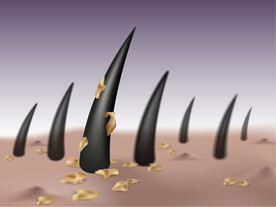Dandruff (Pityriasis Capitis) Clinical Overview
Introduction
Dandruff, or pityriasis capitis, is a common scalp disorder characterized by accelerated epidermal turnover resulting in flaking of the stratum corneum. Although benign and non-inflammatory, dandruff can cause significant pruritus and psychosocial distress. Prevalence estimates range from 10% to 20% globally, with peak incidence in adolescence and early adulthood. This review summarizes epidemiology, pathophysiology, clinical features, differential diagnosis, and evidence-based management strategies for health professionals.
Epidemiology and Risk Factors
- Age and Gender: Most prevalent in adolescents and adults aged 15–50 years; males are affected more frequently than females, possibly due to hormonal influences.
- Environmental Triggers: Cold, dry weather exacerbates scaling; seasonal fluctuations typically show increased flaking in winter months.
- Predisposing Conditions:
- Seborrheic Dermatitis (SD): Shares overlapping features with dandruff; SD is considered an inflammatory form of dandruff with more erythema and pruritus.
- Malassezia Colonization: Lipophilic yeast species (M. globosa, M. restricta) are implicated in disease pathogenesis.
Other factors include neuropsychiatric stressors, obesity, immunosuppression, and Parkinson’s disease, which may alter scalp sebum composition and barrier function.
Pathophysiology
Dandruff arises from hyperproliferation of the scalp epidermis, leading to retention of cornified cells and visible flaking. Key mechanisms:
1. Altered Epidermal Differentiation: Reduced corneocyte cohesion accelerates desquamation, increasing flake formation.
2. Malassezia-Driven Inflammation: Yeast metabolites (e.g., lipases and free fatty acids) disrupt the scalp barrier, triggering subclinical inflammatory responses and further keratinocyte turnover.
3. Sebum Composition: Variations in sebum triglycerides and fatty acids influence Malassezia growth and scalp microbiota balance.
Clinical Features
- Flakes: White to grayish, dorsally adherent to hair shafts and scalp.
- Pruritus: Mild to moderate itch often accompanies flaking; severity correlates with small-scale inflammation.
- Erythema: Minimal or absent; presence of significant erythema suggests seborrheic dermatitis or psoriasis.
- Distribution: Involves scalp convexities (vertex, occiput); may extend to eyebrows, nasolabial folds, and external auditory canal.
Differential Diagnosis
| Condition | Key Features |
|————————-|————————————————–|
| Seborrheic Dermatitis | Erythematous plaques, greasy scale, more itching |
| Psoriasis | Well-demarcated, thick silvery scales, nail changes |
| Atopic Dermatitis | Eczematous lesions, history of atopy, intense pruritus |
| Tinea Capitis | Alopecia, broken hairs, positive fungal culture |
| Contact Dermatitis | Distribution correlates with contactant; patch testing positive |
Diagnostic Evaluation
- Clinical Assessment: History and physical exam usually suffice.
- Wood’s Lamp Examination: May accentuate scaling but not routinely required.
- Fungal Culture or KOH Prep: Reserved for suspected tinea capitis or refractory cases.
- Biopsy: Rarely necessary, unless atypical features suggest alternative diagnoses.
Management Strategies
Non-Pharmacologic Measures
- Scalp Hygiene: Regular shampooing (at least 2–3 times per week) to reduce scale burden and sebum.
- Stress Reduction: Counsel on relaxation techniques; stress can exacerbate flaking.
- Avoid Irritants: Recommend gentle, fragrance-free shampoos and conditioners.
Topical Antidandruff Agents
| Agent | Mechanism | Dosing |
|—————————-|———————————–|—————————————–|
| Zinc Pyrithione | Antifungal, keratolytic | Shampoo 1–2%: 2–3 times weekly |
| Selenium Sulfide | Reduces epidermal turnover | 1%–2.5% shampoo: weekly for 2–4 weeks |
| Ketoconazole | Broad-spectrum antifungal | 1% shampoo: twice weekly for 4 weeks |
| Coal Tar | Keratoplastic, anti-proliferative | 0.5%–5% shampoo: 1–2 times weekly |
| Pyrithione Piroctone | Antifungal, anti-inflammatory | 0.5%–1% shampoo: 2–3 times weekly |
| Salicylic Acid | Keratolytic | 2% shampoo or leave-on lotion |
Notes: Rotate between active agents to prevent tolerance; leave shampoos on the scalp for 3–5 minutes before rinsing. Adjust frequency based on response and tolerance.
Adjunctive and Emerging Therapies
- Topical Corticosteroids: Low-potency preparations for localized SD overlap with inflammation.
- Bifonazole and Other Azoles: Alternative antifungals for ketoconazole-resistant Malassezia.
- Light Therapy: UVB phototherapy for recalcitrant cases; limited by convenience and cost.
- Novel Agents: Investigational DKK1 inhibitors and microbiome-targeted therapies aim to restore barrier and microbial homeostasis.
Special Populations and Considerations
- Pediatric Patients: Use mild formulations and lower concentrations; monitor for irritation.
- Immunocompromised Individuals: More aggressive antifungal regimens and closer follow-up due to higher colonization rates.
- Elderly: Assess for coexistent SD or psoriasis; adjust dosing frequency and watch for skin thinning with tar or corticosteroids.
Patient Education and Follow-Up
- Explain chronic, relapsing nature and set realistic expectations: complete clearance may not be achievable.
- Demonstrate proper application techniques and importance of adherence.
- Schedule follow-up in 4–6 weeks to reassess severity and adjust regimen.
- Provide written instructions and credible online resources to support self-management.
Conclusion
Dandruff is a prevalent, non-inflammatory scalp disorder that, while benign, can significantly affect patient comfort and self-esteem. Health professionals should employ a stepwise, evidence-based approach—beginning with routine scalp hygiene and progressing to targeted topical agents—to achieve optimal control. Emerging therapies and a greater understanding of scalp microbiota hold promise for future innovations in management.







